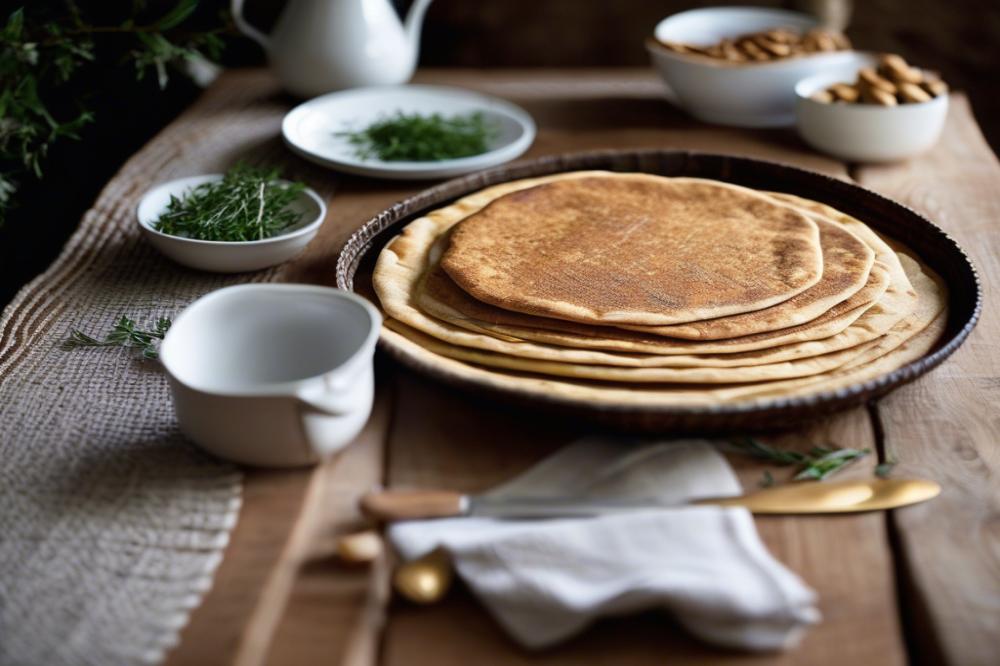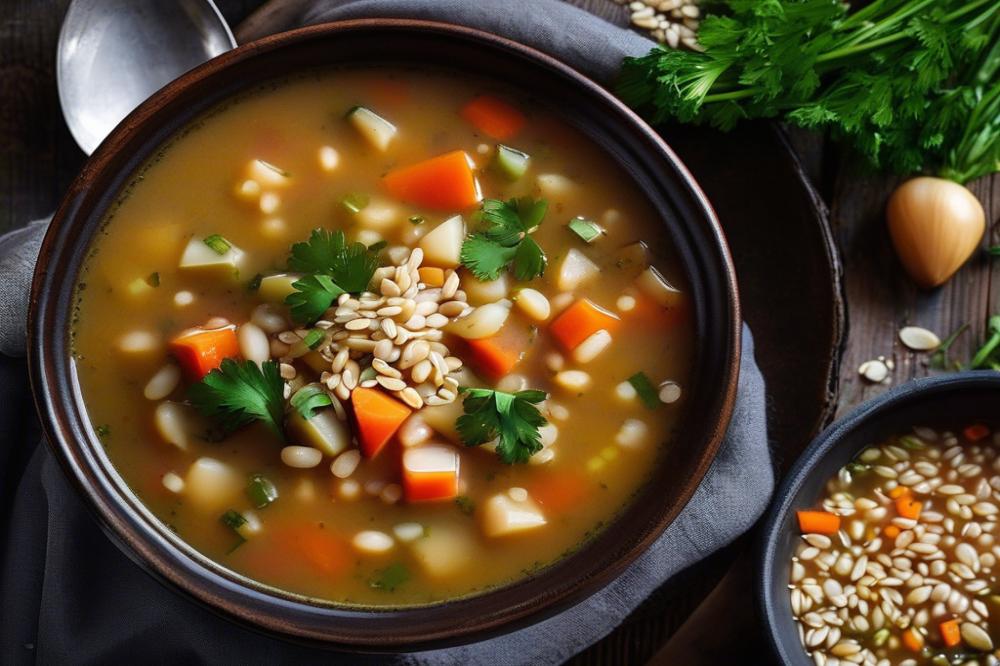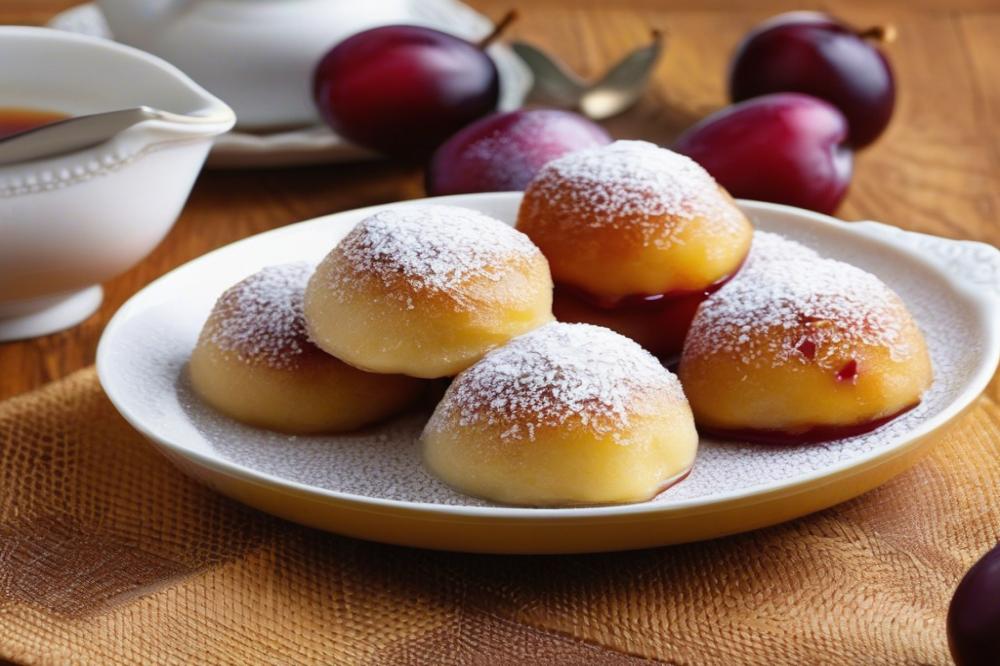Introduction
The Lagana, a type of Greek Flatbread, holds a special place in the hearts of many. This flatbread is traditionally enjoyed during Clean Monday, the first day of Lent. Its significance in Greek culture reflects the importance of fasting and the start of a new season. Many families come together to bake this delightful bread, sharing recipes that have been passed down through generations.
In Mediterranean diets, bread plays a vital role. People use it alongside meals, serving it with olives, dips, and a variety of herbs to enhance their culinary experience. When baked, Lagana boasts a soft, airy texture with a slightly crusty exterior, making each bite enjoyable. Availability may vary by region, leading to unique variations that reflect local ingredients and tastes.
This flatbread uses simple elements yet boasts complex flavors. The dough is made from flour, water, and yeast, and it is generously drizzled with olive oil before baking. Sometimes, herbs are added to the mix, giving it a delightful aroma. This combination of ingredients delivers a wonderful taste that many find comforting. As a staple in many households, it bridges generations and brings people together.
Lagana
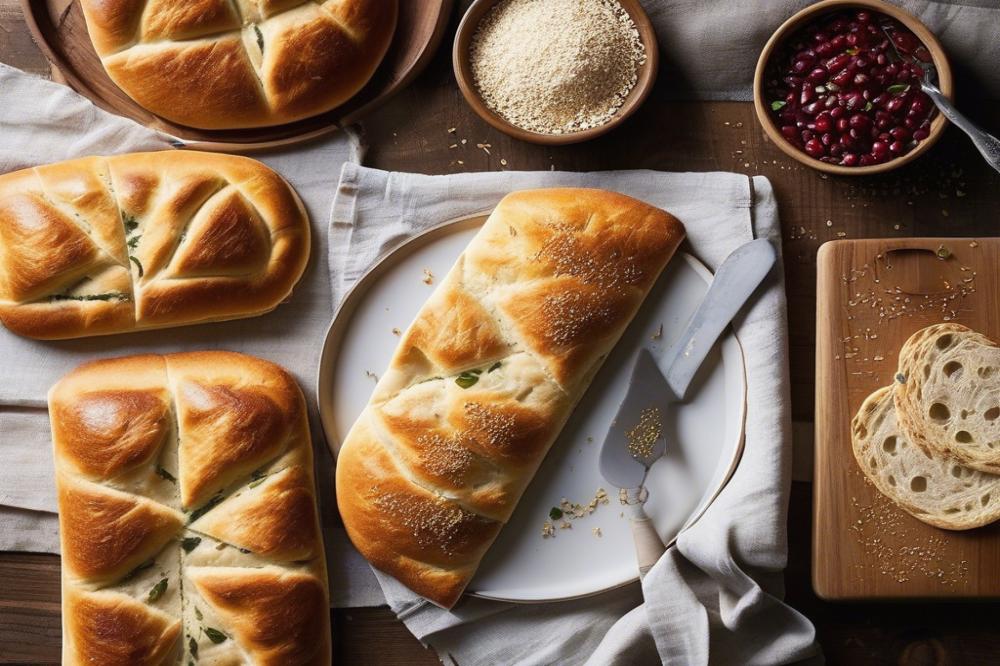
Lagana is a type of Greek Flatbread that holds a special place in Mediterranean cuisine. This bread is usually made with simple ingredients like flour, yeast, and water. Olive oil is often added, giving it a rich flavor and soft texture. Its surface is typically sprinkled with sesame seeds or herbs, enhancing its aroma and taste.
The origins of this delectable bread trace back to ancient Greece, where bread was a staple in daily life. Traditionally, it is baked on Clean Monday, marking the beginning of Lent. This day calls for revelry and the start of a period of fasting. Hence, Lagana symbolizes both a festive occasion and a culinary tradition. It connects people to their roots and to each other through shared meals.
Regional variations are evident throughout Greece. People in the Cyclades often incorporate various herbs into the dough, creating a distinct flavor profile. In contrast, areas in Crete may have different types of sesame seeds or even add olives to the recipe. These differences reflect local customs and the bounty of available ingredients.
baking Lagana can be an enjoyable activity, inviting family and friends into the kitchen. Many families pass down their recipes through generations, each version adding new traits. The process creates not just food, but memories and traditions that last. Different recipes yield unique textures; some may be crispier while others are softer and chewier.
Understanding how to make Lagana can open doors to exploring Greek culture. Each bite of this bread reveals layers of history and significance. The practice of making it connects today’s bakers with ancestors who first enjoyed it hundreds of years ago.
Ingredients for Lagana
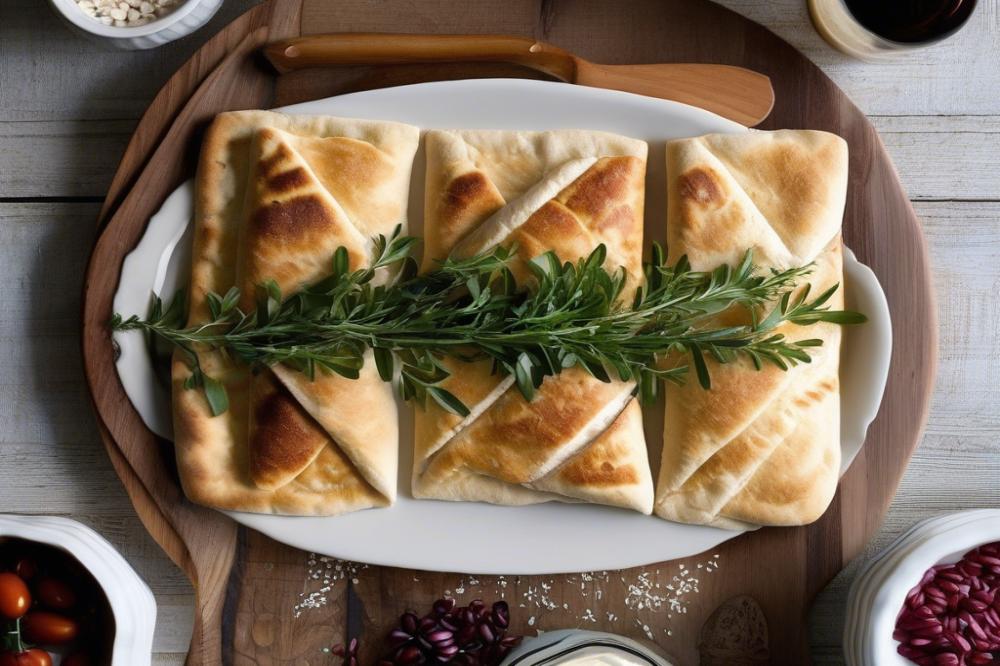
To achieve the perfect Greek flatbread known as Lagana, begin with these essential ingredients:
- 500g all-purpose flour: This is the foundation of the dough. It provides structure and helps create a nice chewiness. Each 100g contains about 364 calories, 10g of protein, 1g of fat, and 76g of carbohydrates.
- 300ml water: Water activates the yeast and hydrates the flour, allowing gluten to develop. It is vital for achieving the desired dough consistency. Water contains no calories and is crucial for a balanced recipe.
- 10g salt: Salt enhances the flavor of the bread. It also controls yeast activity, contributing to the overall texture. Each gram contains only about 0 calories, but it plays a major role in flavor balance.
- 7g active dry yeast: This ingredient is responsible for fermentation. Yeast causes the dough to rise, creating air pockets that result in a light texture. Each packet, containing about 7g, has around 21 calories and offers a small amount of protein.
- 2 tbsp olive oil: Olive oil adds richness and moisture to the flatbread. Its flavor is essential, grounding the taste in a Mediterranean tradition. One tablespoon has about 119 calories and 14g of fat, contributing to the bread’s overall delight.
- 1 tsp sugar: Sugar enhances the yeast’s activity, promoting a better rise. It also contributes a hint of sweetness. A teaspoon has roughly 16 calories and 4g of carbohydrates.
- Optional: herbs (oregano, thyme): These flavorful additions can elevate the taste of Lagana. Fresh or dried herbs offer complexity and aromatic notes. They can be added based on personal preference and dietary choices.
Each ingredient plays a unique role in the final product. The flour provides the necessary foundation, allowing it to hold its shape. Water and yeast work in tandem to create that airy texture we all love. Meanwhile, salt ensures that every bite is flavorful, and olive oil lends a richness typical of traditional Mediterranean baking. Furthermore, sugar acts as food for the yeast, enhancing the fermentation process and adding a touch of depth to the taste.
Varying the herbs allows for a delightful twist; some might prefer a robust oregano flavor, while others might enjoy the subtlety of thyme. This flexibility enables both tradition and personal flair in the recipe. Baking this beloved flatbread requires attention to detail, ensuring the dough rises perfectly while maintaining the integrity of its origin.
Baking Instructions
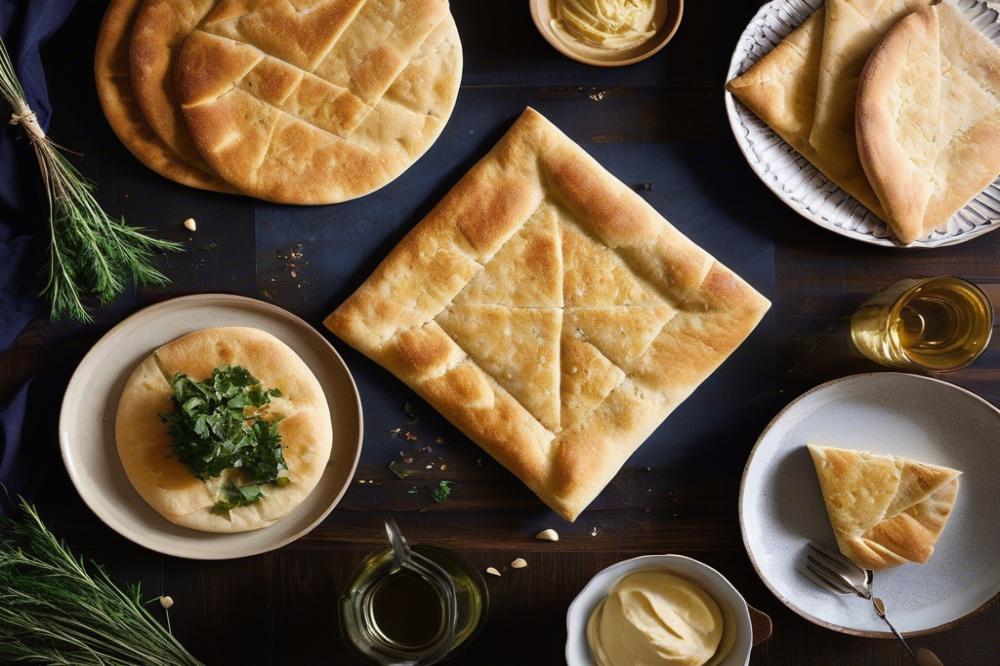
Preparing traditional Lagana involves several important steps. Gathering all ingredients is crucial. You will need flour, yeast, warm water, olive oil, and herbs. Make sure everything is in your kitchen before beginning.
Activation of Yeast
This is the first step. Begin with warm water, about 110°F (43°C). Add yeast and a pinch of sugar. Let this mixture sit for about ten minutes. You’ll know it’s ready when the surface is bubbly and frothy. This froth means the yeast is alive and active.
Mixing Dry Ingredients
In a separate bowl, combine flour and salt. Using a whisk helps blend these ingredients well. You can also add some dried herbs at this stage for added flavor. Rosemary or oregano works beautifully in many variations of this recipe.
Kneading the Dough
Form a well in the flour mixture. Pour in the activated yeast and olive oil. Mix gently with a spoon until the dough starts to come together. Kneading is essential now. Flour a clean surface, and then turn the dough out. Knead it for about ten minutes until it feels smooth and elastic. This process develops the gluten that gives your flatbread a good texture.
First Rise Period
Next, place the dough in an oiled bowl and cover it with a clean cloth. This protects it while it rises. Let it sit for one to two hours in a warm spot. During this time, the dough should double in size. This rise is key for fluffiness.
Shaping Lagana
After the dough has risen, turn it out again and gently deflate it. Divide the dough into equal portions; two to four pieces will do. Shape each piece into a circle or oval on a baking tray lined with parchment paper. Make sure to create a small indentation in the center of each piece. You could drizzle some extra olive oil and sprinkle with herbs for extra flavor.
Second Rise Period
Cover the shaped dough again with a cloth. Allow it to rise for an additional 30 minutes. During this time, you can preheat your oven to 400°F (200°C). This second rise helps develop the texture further.
Baking Temperature and Time
When ready, place the baking tray in the oven. Cook for about 20-25 minutes or until golden brown. Keep an eye on it. You want a crispy exterior while the inside remains soft. A great trick is to tap the bottom; a hollow sound means it’s perfectly baked.
Tips for Achieving the Best Results
Using fresh ingredients makes a noticeable difference. Also, experiment with various herbs for different flavors. Enjoy the Mediterranean tradition as it brings culture to your kitchen. Make sure your oven temperature is accurate, as each oven can vary. Lastly, let the bread cool slightly before cutting into it, as this enhances the taste.
Traditional Serving Suggestions

Lagana is more than just bread; it holds a special place in Greek culture, particularly during Lent and other celebrations. Often, this flatbread is served warm, with a crispy crust and a soft, fragrant interior. Once baked, it pairs beautifully with a variety of dips and spreads.
Olive oil is a popular choice. Drizzled on top, it adds richness and enhances the flavor. Fresh herbs, like oregano or thyme, sprinkled over the bread before baking, make each bite aromatic and delightful. Dips made from chickpeas or fava beans can also create a satisfying experience. Hummus and fava dip, for example, offer a creamy texture that contrasts perfectly with the bread’s crust.
Cheese is another important element on the table. The salty, creamy flavors of feta or kasseri complement the mildness of the flatbread. A cheese platter featuring these cheeses, along with olives and tomatoes, can enhance a meal, bringing a Mediterranean flair to gatherings.
When it comes to main dishes, Lagana can serve as a companion to grilled meats, like souvlaki or lamb. The bread can be used to scoop up flavorful bites, allowing for a delightful combination of tastes. This flatbread sometimes forms part of a meze platter, where small dishes encourage sharing and conversation among guests.
The cultural significance of serving this bread cannot be overlooked. Families and friends often choose to gather around a table that showcases baked breads. During special occasions such as Clean Monday, Lagana is a central dish, signifying the beginning of Lent. Its origin reflects a time when simpler ingredients were used, and variations have developed over centuries.
Baking this bread may seem simple, yet each recipe carries its history. Some may add seeds on top for texture, while others stick to the basics of yeast and flour. No matter the variation, Lagana remains a beloved staple that carries the warmth of Greek hospitality. When served during family meals or festive occasions, it invites everyone to come together, highlighting the true meaning of community and sharing.
Variations of Lagana
Exploring adaptations of this flatbread reveals much about regional tastes. In Greece, each area infuses its own spirit into the recipe. Some regions use different herbs, like rosemary or oregano, to enhance flavor. This can transform a basic loaf into something memorable.
In the islands of the Aegean, locals often add sesame seeds on top of the crust. These seeds provide a delightful crunch and a nutty taste. Furthermore, there are places where bakers use whole wheat flour, making the dough denser and richer. These enhancements offer a twist while maintaining the bread’s origin.
Neighbors in Mediterranean countries also play with the traditional techniques. In Italy, for example, they might swap in sun-dried tomatoes or olives. This idea brings fresh ingredients to the forefront. Yeast remains a constant, but additions create an even more vibrant taste.
Some modern bakers are experimenting even further. By mixing in ancient grains, they offer a healthful alternative. Meanwhile, vegan options have emerged, replacing dairy and focusing on plant-based ingredients. Olive oil remains a cherished staple, with variations in quality and flavor mixing unique local oils into the dough.
Across the region, different methods come into play. In some households, the dough is rolled flat and shaped into small rounds. Others stretch it by hand, allowing for air pockets that increase softness. These methods change the texture, making each loaf distinctive.
Ultimately, the variations of this Greek flatbread highlight how culture influences food. Each recipe tells a story about the land and its people. As bakers continue to explore, they keep the spirit of Lagana alive while adding their own modern twist.
Final Thoughts on the Importance of Lagana in Greek cuisine
A flatbread like Lagana holds a special place in Greek culinary traditions. This bread is not just a dish; it represents a connection to history and culture. Many families cherish the act of baking it together, as it fosters bonds and creates lasting memories.
Trying the recipe for this bread at home could be a delightful experience. The process is simple yet rewarding. Kneading the dough and watching it rise offers a sense of accomplishment. Sharing the warm, freshly-baked bread with loved ones enhances the joy of any meal.
Preserving traditional culinary practices enriches our lives. Each bite of Lagana reflects centuries of heritage, connecting us to our ancestors. Weekend baking sessions provide the perfect opportunity to pass down these traditions while learning about their significance.
Engaging in this art not only creates a delicious product but also cultivates a sense of belonging. Families can gather around the table, enjoying good food and each other’s company. As you embark on this baking journey, remember that every loaf carries with it the spirit of togetherness and celebration.
In summary, embrace the chance to bake and connect with your roots. Take pleasure in creating something meaningful that can be shared with those you cherish. Enjoy the process, relish the taste, and celebrate the wonderful experience of making this cherished flatbread.

